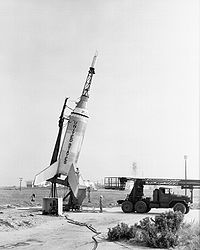
Little Joe 1
Encyclopedia

Solid fuel
Solid fuel refers to various types of solid material that are used as fuel to produce energy and provide heating, usually released through combustion....
rocket
Rocket
A rocket is a missile, spacecraft, aircraft or other vehicle which obtains thrust from a rocket engine. In all rockets, the exhaust is formed entirely from propellants carried within the rocket before use. Rocket engines work by action and reaction...
that was designed to test the Mercury
Mercury program
Mercury Program might refer to:*the first successful American manned spaceflight program, Project Mercury*an American post-rock band, The Mercury Program...
spacecraft Launch Escape and Recovery systems
Launch escape system
A Launch Escape System is a top-mounted rocket connected to the crew module of a crewed spacecraft and used to quickly separate the crew module from the rest of the rocket in case of emergency. Since the escape rockets are above the crew module, an LES typically uses separate nozzles which are...
. The vehicle was 48 ft (14.6 m) in height, weighed approximately 43000 lb (19,504.5 kg), and was 80 in (2 m) in diameter with a fin span of 21.3 ft (6.5 m). The Little Joe booster consisted of four Pollux and four Recruit clustered, solid-fuel rockets, could develop a thrust
Thrust
Thrust is a reaction force described quantitatively by Newton's second and third laws. When a system expels or accelerates mass in one direction the accelerated mass will cause a force of equal magnitude but opposite direction on that system....
of 250000 lbf (1,112.1 kN), and could lift a maximum payload of 3942 lb (1,788.1 kg). The escape system, using a Grand Central 1KS52000 rocket motor, weighed 1015 lb (460.4 kg).
On August 21, 1959, LJ-1 was being prepared for launch from the Wallops Flight Facility
Wallops Flight Facility
Wallops Flight Facility , located on the Eastern Shore of Virginia, is operated by NASA’s Goddard Space Flight Center, primarily as a rocket launch site to support science and exploration missions for NASA and other U.S. government agencies...
, Wallops Island
Wallops Island
Wallops Island is a island off the east coast of Virginia, part of the barrier islands that stretch along the eastern seaboard of the United States of America.It is located in Accomack County, Virginia...
, Virginia
Virginia
The Commonwealth of Virginia , is a U.S. state on the Atlantic Coast of the Southern United States. Virginia is nicknamed the "Old Dominion" and sometimes the "Mother of Presidents" after the eight U.S. presidents born there...
. Suddenly, about a half hour before the scheduled launch, the escape rocket fired and pulled the Mercury spacecraft away from the launch pad. The spacecraft reached an apogee of 2000 ft (609.6 m) and landed about 2000 feet away. The flight time was 20 seconds.
According to the Sept. 18, 1959 accident report, the unexpected triggering of the launch escape system was caused by a transient or electrical leak; analysis showed it to be due to the rapid-abort system being wired directly into the destruct arming busbar
Busbar
In electrical power distribution, a bus bar is a strip of copper or aluminium that conducts electricity within a switchboard, distribution board, substation or other electrical apparatus....
. The batteries were shipped from England to the U.S. uncharged and shorted; on charging at the pad, the batteries, when enough charge was reached, actuated the sequencer for the abort system, and sensing insufficient altitude, fired the squibs in the abort motor. Insufficient power in the batteries then failed to initiate the tower jettison motor and capsule parachute recovery charge, and both crashed into the sea.

